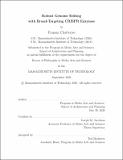Robust genome editing with broad-targeting CRISPR enzymes
Author(s)
Chatterjee, Pranam.
Download1227782835-MIT.pdf (19.74Mb)
Other Contributors
Program in Media Arts and Sciences (Massachusetts Institute of Technology)
Advisor
Joseph M. Jacobson.
Terms of use
Metadata
Show full item recordAbstract
Programmable CRISPR enzymes are powerful and versatile tools for genome editing. They, however, require a specific protospacer adjacent motif (PAM) flanking the target site, which constrains the accessible sequence space for position-specific genome editing applications, such as base editing and precise gene insertion. For example, the standard Cas9 from Streptococcus pyogenes (SpyCas9) requires a PAM sequence of 5'-NG̲G̲-3' downstream of its RNA-programmed target, which limits genome editing applications to around 10% of all DNA sequences. To broaden the targeting range of CRISPR, we first bioinformatically discover and characterize a highly similar SpyCas9 homolog from Streptococcus canis (ScCas9) with a more minimal 5'-NNG̲-3' PAM specificity. Furthermore, we employ motifs from closely-related Streptococcus orthologs to engineer an optimized variant of Sc- Cas9 (Sc++) that simultaneously exhibits broadened targeting capability, robust DNA cleavage activity, and minimal off-targeting propensity. Next, we recombine the PAM-interacting domain of Streptococcus macacae Cas9 (SmacCas9) with SpyCas9, and subsequently introduce enhancing mutations to generate iSpyMac with altered and efficient 5'-NA̲A̲-3' PAM preference. Together, these efforts expand the range of CRISPR nucleases to over 70% of DNA sequences, allowing for targeting of genomic loci that were previously inaccessible, including sequences within candidate genes for denser CRISPR screens and disease-related mutations that can now be fixed with genome editing architectures expressing our engineered variants.
Description
Thesis: Ph. D., Massachusetts Institute of Technology, School of Architecture and Planning, Program in Media Arts and Sciences, September, 2020 Cataloged from student-submitted PDF of thesis. Includes bibliographical references (pages 85-97).
Date issued
2020Department
Program in Media Arts and Sciences (Massachusetts Institute of Technology)Publisher
Massachusetts Institute of Technology
Keywords
Program in Media Arts and Sciences